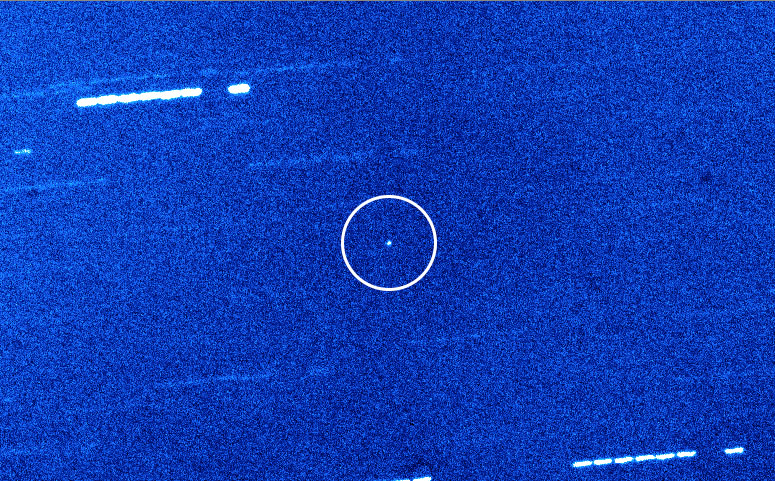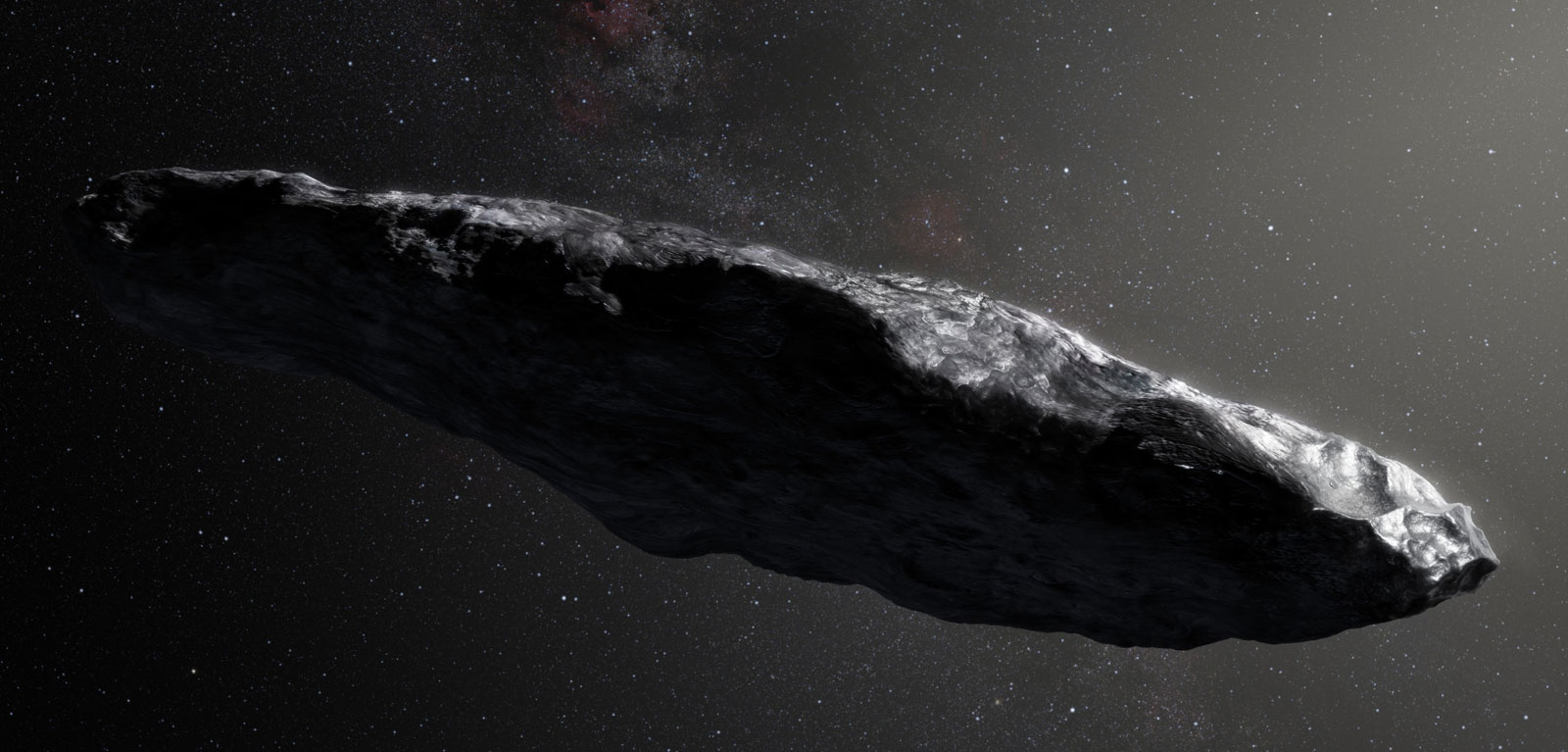Interstellar Object 'Oumuamua Could Be a Comet in Disguise
Although it looks like an asteroid, the first interstellar object spotted passing through the solar system, called 'Oumuamua, may be more like a comet in disguise.
When astronomers first spotted the oblong, tumbling interstellar object 'Oumuamua passing through the solar system in October, they were surprised — not only did it come from outside the solar system, according to its trajectory, it seemed to be an asteroid, rather than the comet researchers thought was more likely for an interstellar visitor.
However, a new paper suggests 'Oumuamua may be made of ice, like a comet, just disguised with a protective crust. ['Oumuamua: The Solar System's First Interstellar Visitor in Photos]

According to professor Alan Fitzsimmons from the Queen's University Belfast, Northern Ireland, there is much more "icy stuff than rocky stuff" in the solar system, making it more likely for emissaries from other systems to also be icy, if other solar systems evolved in the same way.
"We know that our solar system has ejected many more icy bodies than rocky bodies," Fitzsimmons, lead author of the paper published today (Dec. 18) in the journal Nature Astronomy, told Space.com.
As the solar system formed, planets made of gas and ice near the outer edges of the solar system ejected trillions of objects, Fitzsimmons said. In addition, the mass of small icy bodies at the outermost reaches of the solar system, known as the Oort cloud, has lost objects over billions of years due to gravitational disruption from other stars. It was therefore logical for astronomers to expect that the first interstellar visitor they would see should be a comet.
"Given that this object passed relatively close to our sun as it was travelling through our solar system, one would expect any ices on the surface to basically be heated and it should behave like a comet," Fitzsimmons said. "We should see gas streaming off the surface, we should see dust particles being ejected in the cometary atmosphere, perhaps even a tail."
Get the Space.com Newsletter
Breaking space news, the latest updates on rocket launches, skywatching events and more!
But astronomers observing 'Oumuamua with their telescopes have seen no signs of such a behavior. They concluded that the object must be rocky in nature — an asteroid. However, when Fitzsimmons and his colleagues examined data on the surface of the object more closely, they found it doesn't look like a typical asteroid either.
"We didn't see any signs of typical spectroscopic signatures that you would expect from the minerals on the surface of an asteroid we see in our solar system," Fitzsimmons said. "It rather seems to resemble the [icy] objects that are there in the outer solar system. That kind of got our head scratching. If the object had, originally at least, ice in it, what's happened to it?"
Fitzsimmons and his colleagues looked at older studies and laboratory experiments that tried to find out what happens to icy bodies, such as comets, that are exposed for a long time to energetic particles and cosmic rays. These studies suggest that the ice from the surface layers of such bodies evaporates because of the cosmic environment.
"What gets left transforms itself into a relatively rigid and desiccated surface held together by carbon compounds, which at the same time gives a sort of a reddish, pinkish color," Fitzsimmons said. "And that's what we saw in our spectra." [Living on a Comet: 'Dirty Snowball' Facts Explained (Infographic)]

The astronomers ran a series of computer experiments to model the behavior of the now icy 'Oumuamua. They found that if the object's crust was only 20 inches (50 centimeters) thick, it would protect the ice at the object's core from the heat of the sun, thus preventing it from displaying the telltale signs of gas and dust leaving a comet.
In a separate paper that will be published in the Astrophysical Journal Letters later this month, Fitzsimmons' colleague Michele Bannister, also from Queen's University, looked at further properties of 'Oumuamua in the near-infrared spectrum and compared the data with those on similar objects in the outer solar system. She found staggering similarities.
"We've discovered that this is a planetesimal with a well-baked crust that looks a lot like the tiniest worlds in the outer regions of our solar system," Bannister said in a statement. "It has a greyish/red surface and is highly elongated, probably about the size and shape of the Gherkin skyscraper in London."
While 'Oumuamua's arrival has been one of the most significant astronomical events of 2017, Fitzsimmons and Bannister expect that such occurrences will become rather common in the future. Similar objects likely make it into the solar system fairly regularly, the astronomers said, but they are usually too faint to spot with current telescopes. As telescope technology advances, Fitzsimmons said he expects that astronomers in the not so distant future will be able to study such interlopers perhaps every year.
"On the horizon we have a new telescope facility they are building at the moment called the Large Synoptic Survey Telescope in Chile," Fitzsimmons said.
"That's going to be an incredibly powerful survey machine. When that starts operating in the first half of the next decade, that will have a much better chance of detecting these objects in the solar system than the current facilities that we have."
Follow us @Spacedotcom, Facebook and Google+. Original article on Space.com.
Join our Space Forums to keep talking space on the latest missions, night sky and more! And if you have a news tip, correction or comment, let us know at: community@space.com.

Tereza is a London-based science and technology journalist, aspiring fiction writer and amateur gymnast. Originally from Prague, the Czech Republic, she spent the first seven years of her career working as a reporter, script-writer and presenter for various TV programmes of the Czech Public Service Television. She later took a career break to pursue further education and added a Master's in Science from the International Space University, France, to her Bachelor's in Journalism and Master's in Cultural Anthropology from Prague's Charles University. She worked as a reporter at the Engineering and Technology magazine, freelanced for a range of publications including Live Science, Space.com, Professional Engineering, Via Satellite and Space News and served as a maternity cover science editor at the European Space Agency.









